How Much Exercise For Different Dog Breeds
By Michele Welton, Dog Trainer, Breed Selection Consultant, Author of 15 Dog Books
Fencing needed for confinement
Risk of Aggression Toward People
Risk of Aggression Toward Other Dogs
The biggest mistake here is bringing home a dog that needs more exercise and mental stimulation than the owner is willing (or able) to provide.
It's a serious problem when a dog doesn't get sufficient exercise. We all know that exercise is good for us... but it's absolutely vital for dogs.
When dogs get enough exercise
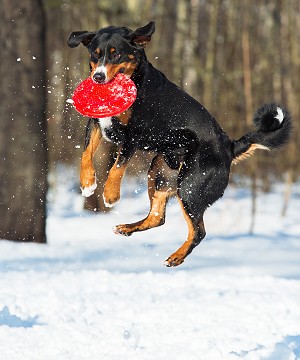
An Appenzeller Mountain Dog is a great family dog if you can provide lots of vigorous exercise. If you can't... then he's a poor (unhappy) family dog!
- Expect easier training. Well-exercised dogs are easier to train because they're calmer, more satisfied, and able to pay more attention to you.
- Expect fewer behavior problems. Well-exercised dogs get into less trouble because tired dogs sleep!
- Expect better health. Exercise keeps your dog's heart, lungs, muscles, and joints strong and healthy, so that he lives a longer, more comfortable life.
When dogs don't get enough exercise
- Expect behavior problems. Dogs who are not getting enough exercise often vent their pent-up energy through barking, digging, or destructive chewing. Many dogs described as hyperactive are acting that way because their owner isn't giving them enough exercise.
Dogs are active, bright animals. If they don't have anything to do except wander aimlessly around the house or yard, they feel bored and frustrated. Dogs express boredom and frustration by destroying things, barking, or being rambunctious.

Bored. Bored. Bored. Plus, they're loose in the house with no one home – a privilege which they clearly haven't earned yet!
It's harder to make a dog conform to your expectations when HIS needs aren't being met. Yes, you need to stop him from destroying things and barking (see my free online training program at the bottom of this page), but you should also add more exercise and interesting activities to his life.
- Expect health problems and a shorter life. Lack of exercise weakens your dog's heart, lungs, and joints, which makes them more vulnerable to disease. Lack of exercise also leads to weight gain, and overweight dogs are more likely to develop diabetes, heart disease, joint diseases, and digestive diseases.
The moral is... don't get a dog that needs more exercise and mental stimulation than you're willing (and able) to provide.
The myth of "exercising" in the back yard
Some owners think they have a foolproof solution to the exercise issue...
...the back yard.
Are you thinking (hoping) that your dog will be able to get all the exercise he needs by "running around" your yard?
That might be true if you get a tiny dog, a senior dog, a handicapped dog, or a dog with health issues that can't handle a lot of exercise.
But for most other dogs, "exercising" in the back yard just doesn't happen. Most dogs just wander around in a leisurely manner, sniffing, peeing, sniffing, picking up a stick, sniffing, dropping the stick, sniffing, pooping... then they sprawling in the sun (or shade) and snoozing.
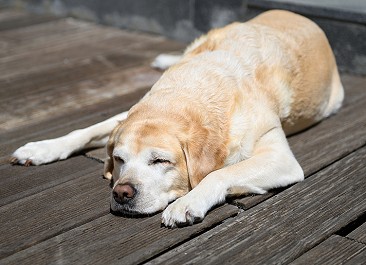
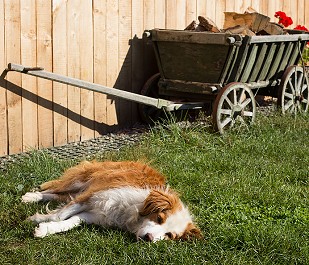
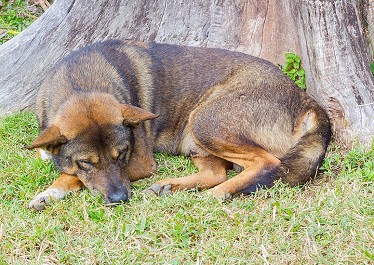
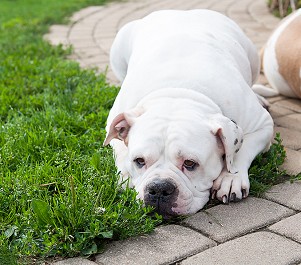
"Exercising" in the back yard. At least the Bulldog is awake.
Fence running may be "exercise", but it's psychologically unhealthy
Some dogs do "exercise" in the back yard – they race up and down the fenceline, barking at passersby, UPS trucks, the neighbor's dog, or the neighbors themselves.
These dogs are not having fun. They're bored, frustrated, and venting.
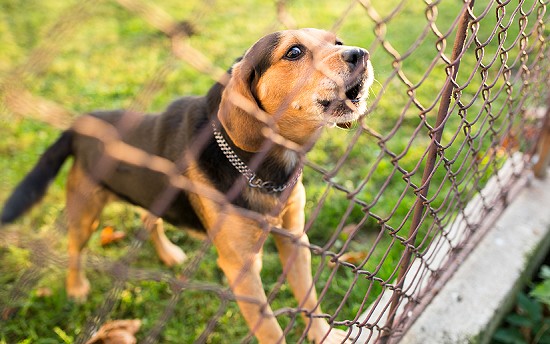
This Coonhound is not only annoying everyone within earshot, but also practicing bad habits – excitability and making noise. These are not desirable behaviors in a family dog.
Can TWO dogs keep each other exercised?
Could be. If you have multiple dogs and they really DO chase and romp and wrestle with each other, that will burn off a lot of energy. Just add some brisk walks, ball-playing, or stick-fetching.
However...
Just because you have two dogs, it's not a done deal that they will exercise each other. Many dogs who live together do just that – live together . They might follow each other around, but that isn't exercise.
Now if YOU go outside and walk (or run) around the yard with your dog, he will get much more exercise, especially if you play Fetch or Tug games.
What is mental exercise/stimulation?
I'm going to start a sentence, and I believe you can finish it for me! Ready?
Most dog breeds were developed to do some form of....
(yes!) WORK. Well done!
Breeds with a working heritage require a lot of exercise – not only physical exercise, but also mental exercise.
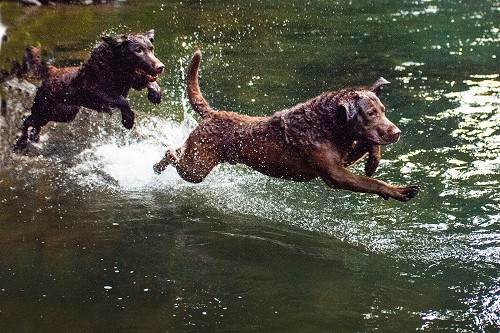
Chesapeake Bay Retrievers were developed to work all day retrieving shot geese from the icy waters of Chesapeake Bay. Tough dogs, great stamina and endurance – three traits that make this dog a phenomenal working dog... but not a phenomenal pet unless you're prepared to provide loads of exercise both physical and mental.
By mental exercise, I mean providing the dog with something interesting to do, something that stimulates his mind. Without both physical and mental exercise, many breeds become bored, frustrated, and likely to vent their unhappiness through mischief and behavior problems.
- Something to do might include intellectually stimulating games such as hide and seek (where you hide and your dog looks for you); or find the hidden toy (where you hide a toy and your dog looks for it); or an obstacle course in your yard.
- Something to do might include hunting or hiking/backpacking trips, or swimming and fetching sticks at the lake, or herding or guarding livestock on your farm.
- Something to do might include regular classes at a local dog club, learning advanced obedience, agility, tracking, herding, scent-work, weight-pulling, protection sports, carting, or sledding.
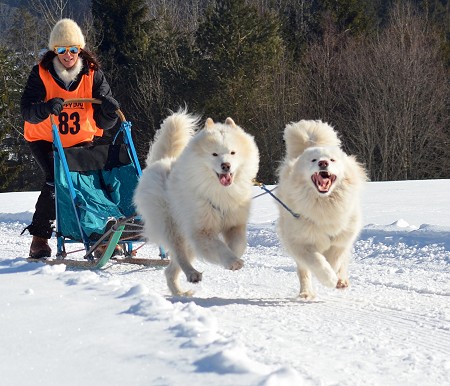
Samoyeds pulled sledges and herded reindeer for the nomadic Samoyedic peoples of Siberia. When the polar expeditions to the Arctic and Antartic were outfitted, Samoyeds were represented. No surprise then, that this hardy, adventurous breed should be owned by athletic outdoor enthusiasts.
Of the 200+ breeds readily available in the US, more than HALF have working backgrounds and need a lot of physical exercise and mental stimulation (unless you adopt an older or handicapped individual). Can you see why crossbred dogs and mixed breed dogs are so worthy of consideration when you're simply looking for a pet?
Breeds that need only MINIMAL exercise
Look at this list. Are these the only forms of exercise you're able to provide?
- Play daily games of fetch, if your dog will play.
- Set up a miniature obstacle course and run around it with him, coaxing, encouraging, and rewarding.
- Teach tricks.
- In nice weather, go for walks. (Most of these breeds dislike wet or cold weather.)
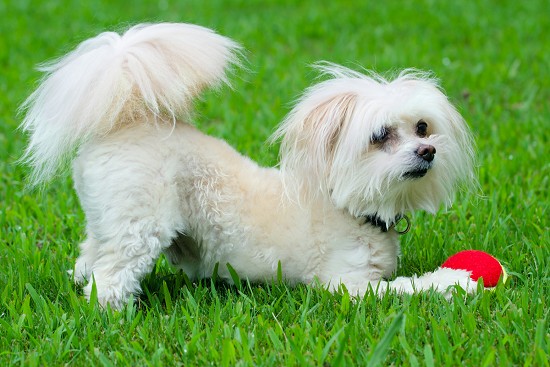
Although not needing too much exercise, this crossbred Maltipoo won't turn it down if you offer more! Most tiny dogs love to run and play.
Tiny dogs who do okay with MINIMAL exercise:
| Affenpinscher | Papillon |
| Brussels Griffon | Pomeranian |
| Chihuahua | Toy Fox Terrier |
| Dachshund | Toy Manchester Terrier |
| Japanese Chin | Toy Poodle |
| Maltese | Yorkshire Terrier |
| Miniature Pinscher |
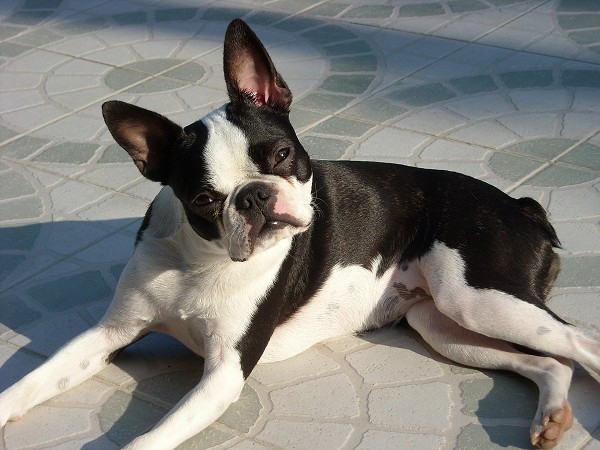
Boston Terriers don't need too much exercise... but most young and middle-aged individuals are playful and fun-loving. Seniors are more sedate. DON'T exercise this breed in hot weather, as they have respiratory issues caused by their deformed facial structure.
Small dogs who do okay with MINIMAL exercise:
| Bichon Frise | Lowchen |
| Boston Terrier | Pekingese |
| Coton de Tulear | Pug |
| Dachshund | Shih Tzu |
| English Toy Spaniel | Silky Terrier |
| Havanese | Tibetan Spaniel |
| Lhasa Apso |
Midsize and medium-size dogs who do okay with MINIMAL exercise:
| French Bulldog |
| English Bulldog |
Breeds that need LOTS of exercise
Here we have dog breeds at the opposite end of the exercise spectrum. Developed to work all day, these breeds need a great deal of physical and mental exercise.
- Start with a 45-minute BRISK walk, twice a day – BRISK so the dog is trotting rather than just plodding along.
- Daily, or at least every other day, provide energetic activities such as running (offleash? read this first), fetch games, tug games, obstacle course, hiking, swimming, carting, hunting, advanced obedience or tricks, tracking, herding, scent-work, weight-pulling, sledding, protection sports, or any other activity this particular dog enjoys.
Small and midsize dogs who want LOTS of exercise:
| Border Terrier | Jack Russell Terrier |
| Fox Terrier | Lagotto Romagnolo |
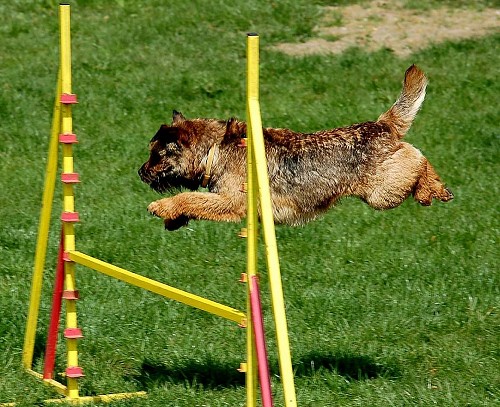
Border Terriers are real go-getters. They're not hyperactive, but they're determined to find challenging things to do. Owners need to provide interesting activities, else the Border will find them himself!
Medium-size dogs who want LOTS of exercise:
| Australian Cattle Dog | English Springer Spaniel |
| Australian Kelpie | Entlebucher Mtn Dog |
| Australian Shepherd | Nova Scotia Duck Toller |
| Border Collie | Portuguese Water Dog |
| Brittany | Siberian Husky |
| English Shepherd | Vizsla |
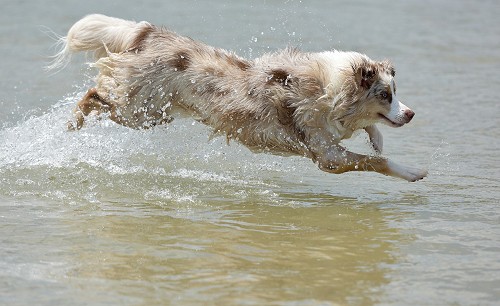
Australian Shepherds want to do stuff. Interesting stuff. Lots of interesting stuff! If that doesn't sound like your family, you should either adopt a senior Aussie who is more sedate, or you should choose a different breed. Because young and middle-aged Aussies want to do lots of interesting stuff!
Large and giant dogs who want LOTS of exercise:
| Airedale | Dalmatian |
| Alaskan Malamute | English Pointer |
| American Bulldog | English Setter (field type) |
| Appenzeller Mtn Dog | Flat-Coated Retriever |
| Beauceron | German Shorthair |
| Belgian Shepherd | German Wirehair |
| Coonhound | Giant Schnauzer |
| Bouvier des Flandres | Gordon Setter |
| Briard | Irish Setter |
| Cane Corso | Labrador Retriever (field) |
| Catahoula Leopard | Spinone Italiano |
| Curly-Coated Retriever | Weimaraner |
One of the biggest mistakes dog owners make is bringing home a dog whose exercise requirements are well over the owner's willingness (or ability) to provide for. If you're a couch potato, the breeds above are not for you!
Breeds that need MODERATE exercise
Which breeds need moderate exercise? Whichever breeds I've written Reviews for that I haven't included under MINIMAL or LOTS.
About half of all dog breeds need moderate exercise.
Look at the lists above that give you some exercise ideas for dogs who need MINIMAL and dogs who need LOTS. The same forms of exercise are recommended for dogs who need MODERATE.
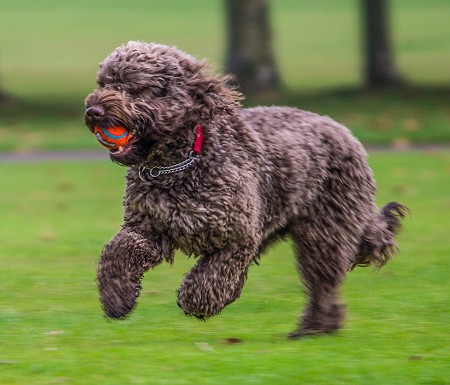
Cockapoos are bright, active crossbreed dogs who need moderate exercise. They love to romp and play and do fun stuff.
Sighthounds need a special type of exercise:
Interested in one of these breeds? Afghan Hound, Borzoi, Greyhound, Ibizan Hound, Irish Wolfhound, Italian Greyhound, Pharaoh Hound, Saluki, Scottish Deerhound, Whippet?
They're all sighthounds , which is a family of tall, slender, long-legged hunting dogs. Their job is to spot the slightest movement of prey across vast distances, then run it down with their blazing speed.
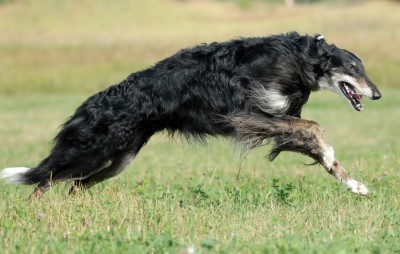
Borzoi, aka Russian Wolfhound. Guess what animal they used to hunt?
Sighthounds don't need miles of running. Their forte is sprinting, not endurance. What they need is a large, safely fenced yard where they can suddenly explode into an immensely powerful, driving, floating gallop that no other dog breed can match.
But after a few full-throttle circuits of the yard, a sighthound is ready to call it quits and snooze on your comfy sofa... at least until later when he'll be ready and eager to run more laps.
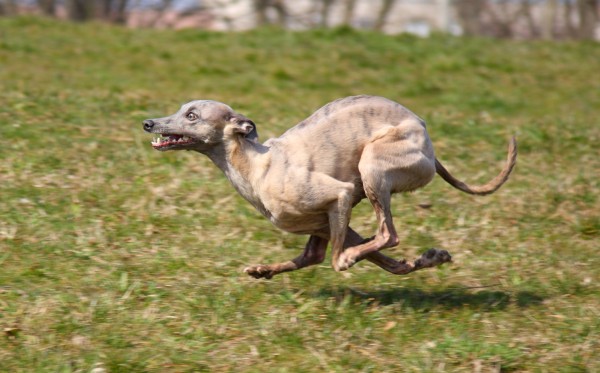
Whippet
Sighthounds, then, shouldn't be kept in a small yard, or an improperly fenced yard. Electronic/invisible fencing? No – if some running critter catches their attention, they'll blaze right through any "shocks", catch and kill the unfortunate prey, then never come back.
Sighthounds need a very large yard with high fencing, as they are outstanding jumpers.
For sighthounds, see if there is a dog club in your area that offers an activity called lure coursing, which is chasing after a mechanical lure in a controlled setting. This is a constructive outlet for the full-throttle galloping behaviors that are "hardwired" into your sighthound's genes.
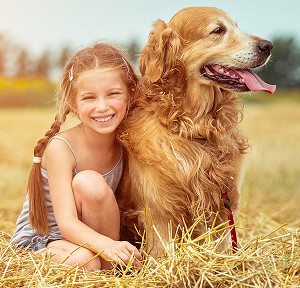
If exercise is a problem for you, adopt a senior dog who doesn't need too much.
What if a breed is a perfect match for you, and you can provide for all its needs... except the exercise?
Contact shelters and rescue groups and ask about adopting a senior dog. With their youth and high-energy days behind them, senior dogs are usually much more mellow and laid-back, and exercise requirements are more modest.
My best-selling books – now available FREE on my website
 Respect Training For Puppies: 30 seconds to a calm, polite, well-behaved puppy is for puppies 2 to 18 months old. Your puppy will learn the 21 skills that all family dogs need to know. Click here to read for free.
Respect Training For Puppies: 30 seconds to a calm, polite, well-behaved puppy is for puppies 2 to 18 months old. Your puppy will learn the 21 skills that all family dogs need to know. Click here to read for free. Teach Your Dog 100 English Words is a unique Vocabulary and Respect Training Program that will teach your adult dog to listen to you and do what you say. Click here to read for free.
Teach Your Dog 100 English Words is a unique Vocabulary and Respect Training Program that will teach your adult dog to listen to you and do what you say. Click here to read for free. 11 Things You Must Do Right To Keep Your Dog Healthy and Happy helps your dog live a longer, healthier life. Get my honest advice about all 11 Things before you bring home your new puppy, because some mistakes with early health care cannot be undone. Click here to read for free.
11 Things You Must Do Right To Keep Your Dog Healthy and Happy helps your dog live a longer, healthier life. Get my honest advice about all 11 Things before you bring home your new puppy, because some mistakes with early health care cannot be undone. Click here to read for free.
